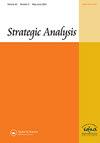China in India’s Post-Cold War Engagement with Southeast Asia
IF 0.5
Q3 INTERNATIONAL RELATIONS
引用次数: 0
Abstract
T he commemoration of 2022 as the ‘ASEAN-India Year of Friendship’ marks thirty years of the partnership between India and the Association of Southeast Asian Nations (ASEAN). Beginning in 1992 with India’s ‘Look East Policy’ (LEP), renamed ‘Act East Policy’ (AEP) in 2014, India has progressed from being a Sectoral Partner of ASEAN in 1992 to a Dialogue Partner in 1996 and a Summitlevel Partner in 2002. The transition in India’s approach not just underscores the continuing importance of Southeast Asia in New Delhi’s strategic calculus, but also highlights the reinvigoration of Indian foreign policy under the changed geopolitical dynamics of the Indo-Pacific in the Asia-Pacific security architecture. Besides, India has maintained the centrality of the ASEAN not just under the LEP/AEP but also in its Indo-Pacific vision. Here, the key query that demands attention is: what explains India’s approach to the region over three decades? Chietigj Bajpaee’s China in India’s Post-Cold War Engagement with Southeast Asia departs from the conventional understanding in explaining India’s engagement with Southeast Asia in the backdrop of economic liberalization and the maturing regional architecture in Asia as well as the growing importance of transnational security threats. In doing so, the book bases itself in answering three queries in finding a rationale to India’s attitude and behaviour towards Southeast Asia. First, why has India made such a concerted effort towards Southeast Asia as opposed to other strategically significant regions, including the Middle East (West Asia), Central Asia or its immediate neighbourhood of South Asia? Second, why has India’s engagement with the region accelerated over time as the relative importance of Southeast Asia to regional and global growth was on a decline? And third, why has India continued to cling to the principle of ‘ASEAN centrality’ in its regional engagement (p. 2)? Accordingly, the book is systematically presented and is structured with eight chapters that include an introduction and a conclusion, and encompasses the historical context, methodological tools, understanding of LEP from its launch to its evolution under two phases (1992-2004 and 2004-2014) and finally the ‘Act East’ phase from 2014 onwards. In finding the explanations, Bajpaee draws his reasoning by postulating the ‘China factor’, interpreted as ‘China’s regional role’, and offers a more credible Strategic Analysis, 2022 Vol. 46, No. 6, 641–643, https://doi.org/10.1080/09700161.2022.2149985冷战后印度与东南亚交往中的中国
2022年是“东盟-印度友好年”,标志着印度与东南亚国家联盟(东盟)建立伙伴关系30周年。从1992年开始,印度的“向东看政策”(LEP)于2014年更名为“向东行动政策”(AEP),印度从1992年的东盟部门合作伙伴发展为1996年的对话伙伴和2002年的峰会伙伴。印度方法的转变不仅突显了东南亚在新德里战略考量中的持续重要性,还突显了印度外交政策在亚太安全架构中印度-太平洋地缘政治动态变化下的重振。此外,印度不仅在LEP/AEP下,而且在其印太愿景中,都保持着东盟的中心地位。在这里,需要关注的关键问题是:是什么解释了印度30多年来对该地区的态度?Chietigj Bajpaee的《冷战后印度与东南亚的接触中的中国》在解释印度在经济自由化和亚洲日益成熟的地区架构以及跨国安全威胁日益重要的背景下与东南亚接触时,偏离了传统的理解。在这样做的过程中,这本书以回答三个问题为基础,为印度对东南亚的态度和行为寻找理由。首先,为什么印度对东南亚做出如此一致的努力,而不是对其他具有重要战略意义的地区,包括中东(西亚)、中亚或其邻近的南亚?其次,为什么随着东南亚对地区和全球增长的相对重要性下降,印度与该地区的接触随着时间的推移而加速?第三,为什么印度在其区域参与中继续坚持“东盟中心地位”的原则(第2页)?因此,本书系统地介绍了LEP,共有八章,包括引言和结论,包括历史背景、方法工具、对LEP从推出到分两个阶段(1992-2004和2004-2014)演变的理解,以及从2014年起的“向东行动”阶段。在寻找解释时,Bajpaee通过假设“中国因素”得出了他的推理,被解释为“中国的区域作用”,并提供了一个更可信的战略分析,2022年第46卷,第6期,641-643,https://doi.org/10.1080/09700161.2022.2149985
本文章由计算机程序翻译,如有差异,请以英文原文为准。
求助全文
约1分钟内获得全文
求助全文

 求助内容:
求助内容: 应助结果提醒方式:
应助结果提醒方式:


